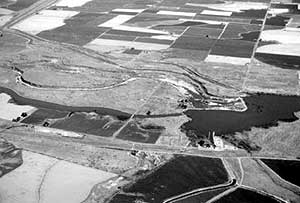Section
3, Chapter 8 -"Famous Potatoes" Agriculture & Irrigation
|
|
Chapter 8:
Water in Idaho
Mormon Settlements and the use of Water
Irrigation of the Snake River System
Snake River Plain Aquifer
The Growth of Agricultural Idaho
Early Irrigation Failures
Ira Burton Perrine
Minidoka Project
American Falls Dam
Irrigation of the Snake River Plain
The Swan Falls Controversy
The Teton Dam Disaster, June 5, 1976
Agriculture Today
Sidebars:
Idaho and the Great Depression
|
|
| Milner
Dam, the fount of the Magic Valley, looking north, (July, 1989). The dam
was begun in 1904 and finished in 1905. Note the dam is in the middle of
a scabland swath cleaned of soil by the Lake Bonneville Flood. The Oregon
Trail passed along the south side of the Snake River here and ruts are preserved
in a Bureau of Land Management recreation site. The Twin Falls Branch of
the Union Pacific Railroad runs south of the river. From north to south
the arteries of Snake River water to irrigate the Magic Valley are the Milner-Gooding
Canal, the North Side Canal, the Snake River in its canyon, the South Side
Main or Twin Falls Canal, and heading south directly at the camera, the
Milner Low Lift Main Canal. This was near the point where the Wilson Price
Hunt Party in 1811 got into trouble in navigating the Snake River by boat.
A few miles downstream, at Caldron Lynn, they gave up their river journey
and set off on foot, headed for Fort Astoria. |
Water
in Idaho
One of the
most important features of life in the intermountain area of the United States
is water. Both because there is so little of it available and because water
for agricultural uses must be stored in reservoirs or obtained from underground
sources, the subject of water occupies the attention of many people. In water-short
years, there is a real concern that there will not be enough to go around and
that crops may suffer. Climatic patterns are cyclical. There are both drought
years and wet years when winter snowfall has been adequate and spring rains
have soaked into fields and watersheds. Water is a matter of constant concern.
|
.State
law mandates that the slogan "Famous Potatoes" appear on standard
Idaho automobile license plates!
.
|
Idaho contains parts of
three major drainage basins: the Salmon River and other tributaries of the Columbia
in the mountainous northern part, the Bear River and Great Salt Lake in the
southeast, and the Snake River, which is the lifeblood of the agriculture in
southern Idaho. Northern Idaho has a wetter climate and the need for water storage
is much less essential. In the south, the weather is warmer and drier. Water
storage is absolutely necessary.
The fur trappers were
little bothered with water resources. As long as beaver could build dams in
the forested areas, trappers were mainly unconcerned with how much moisture
fell during the year.
As the Pioneers of the Oregon
and California Trails passed through southern Idaho, they were appalled by the
dust, the lack of water and the obvious hostility of the land. They hurried past,
expressing doubt that the vast desert wilderness would ever support civilization,
much less irrigated agriculture. It is wonderful irony how wrong they were.
top
